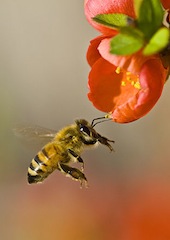Why are Honey Bees Critical for Human Survival?
Fewer honey bees mean less to eat and higher food prices
May 17, 2014

1. Honeybees pollinate more than 90 of the world’s flowering crops, including apples, nuts, broccoli, squash, citrus fruit, berries and melons.
2. One quarter of the U.S. diet – from apples to cherries to watermelons to onions – depends on pollination by honeybees.
3. Fewer bees mean smaller harvests on farms around the world, which also means higher food prices.
4. A mysterious disease, called Colony Collapse Disorder, has been killing honeybees since 2005.
5. Some experts say that colony collapse disorder got worse in 2013 but others say it has abated in recent years.
6. Nearly one-fourth (23%) of bee colonies in the U.S. failed in the winter of 2013-2014.
7. There was a massive die-off of approximately 100,000 hives in the California almond fields in early 2014.
8. Experts now say the problem is a combination of parasitic mites, a new class of pesticides and poor nutrition for bees due to a lack of diversity in crops.
9. A class of pesticides (neonicotinoids) is part of the problem, according to European regulators. The U.S. EPA is being sued for conditionally approving neonicotinoids.
10. There are now about 150 chemical residues found in pollen and wax from beehives.
News sources: Bee colony collapse poses a threat to crops by Michael Wines (International Herald Tribune/USDA) and Bees still dying at worrisome rates by Seth Borenstein (Washington Post).
Takeaways
There are now 150 chemical residues in pollen and wax from beehives. Some may cause colony collapse.
Neonicotinoid pesticides, approved for use in the U.S., may cause colony collapse, say EU regulators.
Honey bees pollinate over 90 of the world's flowering crops.
Fewer bees mean less to eat and higher prices.
Author
The Globalist
Read previous

Where China Truly Innovates
May 15, 2014